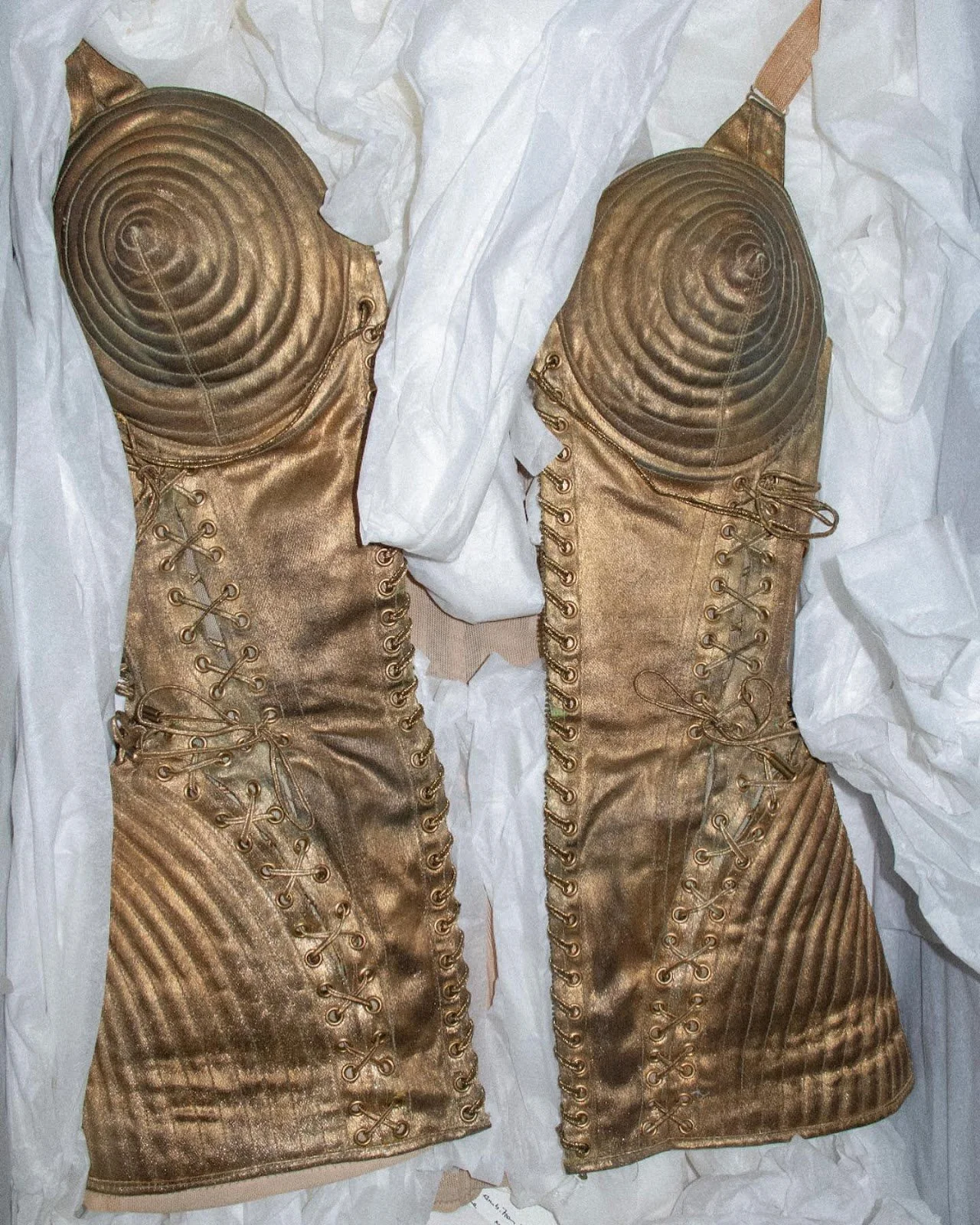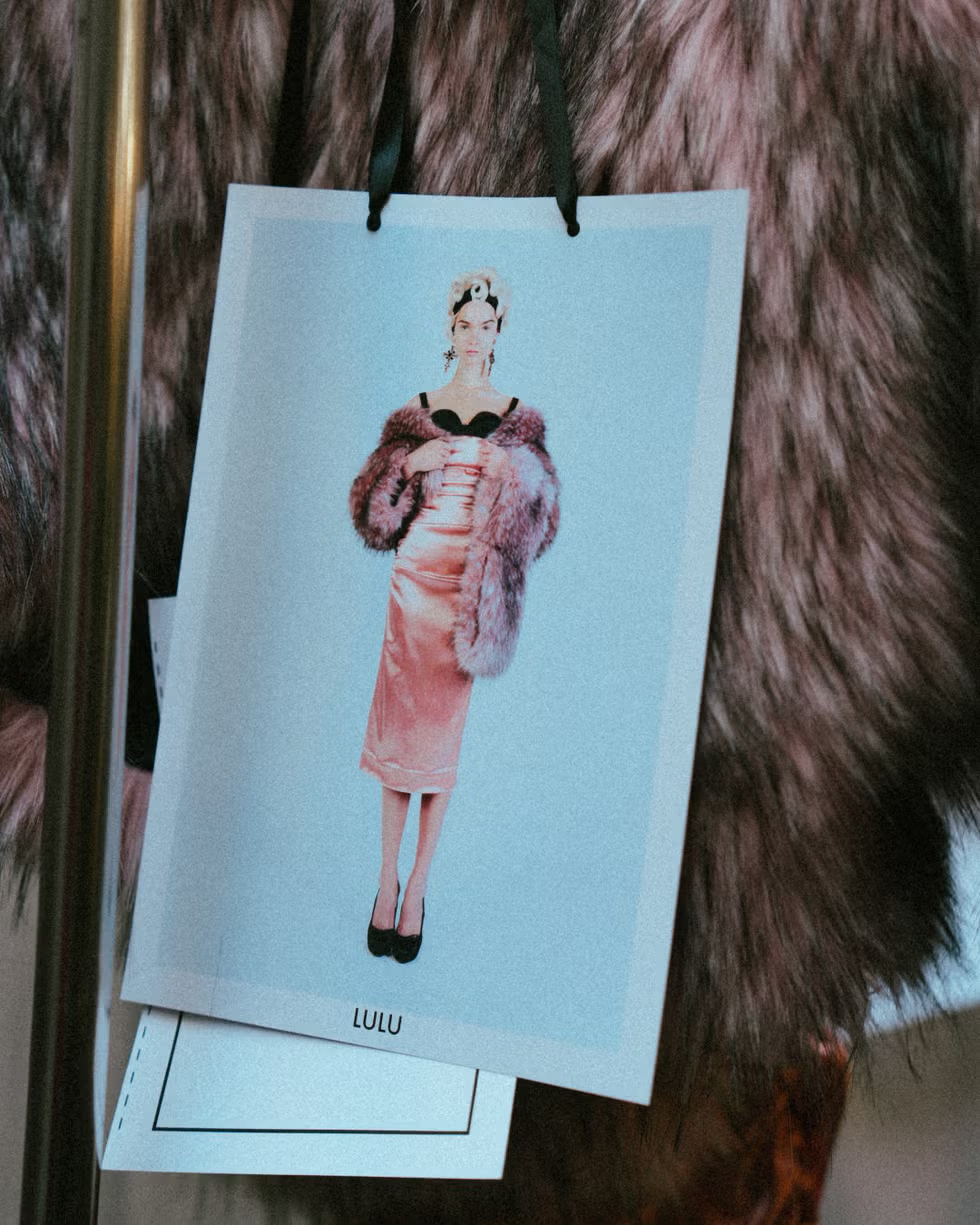Borderline of Tributes
Dolce & Gabbana’s Spring / Summer 2025 show at Milan Fashion Week was set to be a tribute to Madonna’s legendary influence on pop culture and fashion. The event sparked online buzz, not only from the presence of Madonna herself but also because of the revival—some might even say overuse—of one of her most iconic looks: the cone bra, also famously associated with Jean Paul Gaultier. With the lines between tribute and imitation blurred, did the brand overstep by leaning too heavily on borrowed references?
A model in a black suit with cone bra details backstage at the Dolce & Gabbana Spring / Summer 2025 show getting touch-ups on the Madonna-esque blonde wig that the models were styled in. Photographed by Matteo Bianchi for Harper's Bazaar, September 2024. Available via Harper's Bazaar. © All rights belong to their respective owners. No copyright infringement intended.
The cone bra was undoubtedly an essential part of Madonna's story, making its inclusion difficult to exclude. The cone bra, famously linked to Jean-Paul Gaultier and Madonna, has evolved from its 1940s origins to become a powerful symbol of both empowerment and controversy in fashion. Initially, the bullet bra, introduced by Perma-Lift during World War II, featured a cone shape that offered structure without underwires. This design gained popularity in the 1950s, worn by Hollywood icons like Marilyn Monroe and transforming into a mainstream emblem of femininity. Gaultier reinterpreted the vintage shape in the 1980s, debuting an exaggerated, hyper-sexy version in his Fall/Winter 1984 collection Barbès. Gaultier initially presented the design in 1987, and its provocative nature became a perfect match for Madonna’s daring stage persona. The cone bra gained international fame and association with Madonna during the Blonde Ambition tour in 1990 cementing its reputation as a bold, sensual statement piece and iconic garment in fashion history.
Since then, the cone bra has continued to inspire contemporary fashion, appearing on runways and red carpets alike. The cone or bullet bra has re-emerged in various collections over the decades, symbolizing a blend of retro charm and avant-garde rebellion. Designers such as Daniel Roseberry for Schiaparelli have explored new interpretations, blending the silhouette into collections in a surrealist interpretation. Most recently, this trend was showcased by various celebrities at the 2024 Met Gala, including Kylie Jenner in a classic ivory Oscar de la Renta gown and Charli XCX in a dress made of patchwork white shirts created by Marni. However, Dolce & Gabbana’s use faced criticism for heavily featuring the design in such treatment, as some believed they borrowed too much from Jean Paul Gaultier’s style for Madonna instead of creating a unique reinterpretation or using it more sparingly for impact.
A photo from Madonna’s personal archives of a conical bra corset. Via IG @madonna © All rights belong to their respective owners. No copyright infringement intended.
When a collection is inspired by Madonna, it’s easy to argue that the inclusion of the cone bra makes sense. Madonna has worn the cone bra in some of her most defining moments, making it inseparable from her persona. Beyond the cone bra, Dolce & Gabbana incorporated several other references to Madonna’s iconic looks throughout her career. The collection included nods to her Who's That Girl tour in 1987, the sharp suits she has donned from performances to video appearances, and even a lacy corset paired with baggy pants—a direct homage to a 1989 look.
While Dolce & Gabbana explored Madonna’s style history, the cone bra inevitably cast a long shadow, one that drew attention away from Dolce & Gabbana’s typical aesthetic. This instantly complicated the narrative Dolce & Gabbana sought to tell. What should have been a celebration of Madonna felt more like a Jean Paul Gaultier tribute, raising concerns about the originality of Dolce & Gabbana’s vision. Even though they ventured beyond just the cone bra—featuring a final look that referenced Madonna’s appearance at the Truth or Dare premiere in 1991—many critics still felt the show heavily borrowed from Gaultier’s iconic fashion moments, questioning whether it is fair for Dolce & Gabbana to recycle such a heavily associated image, particularly when Jean Paul Gaultier himself and his namesake brand is still an active force in the fashion world, despite his retirement in 2020.
A model’s comp card styling with matching look on a rack backstage at the Dolce & Gabbana Spring / Summer 2025 show. Photographed by Matteo Bianchi for Harper's Bazaar, September 2024. Available via Harper's Bazaar. © All rights belong to their respective owners. No copyright infringement intended.
Dolce & Gabbana's recent collections seem to be caught in a loop of self-referencing, with frequent callbacks to the 1990s and 2000s. While nostalgia has played well in fashion, there’s a point where it starts to feel repetitive and stale. Audiences are craving something new, something reflective of the future, rather than endless rehashes of the past. Could this indicate a need for fresh talent to take over the house? In an industry that thrives on innovation, staying rooted in the past may limit the brand’s ability to evolve.
The brand also has been affected by numerous scandals that have significantly impacted the it's reputation. From controversial comments by the creative directors—often touching on sensitive issues such as sexuality, race, and body image—to ad campaigns featuring culturally insensitive racist imagery, the brand has repeatedly found itself at the center of public outrage. These controversies have not only alienated certain customer groups but have also led to boycotts and withdrawals from major retailers, putting the brand's long-term credibility at risk.
In the face of such backlash, Dolce & Gabbana seems to be increasingly relying on high-profile celebrities and nostalgic gimmicks to divert attention away from their checkered history and a perceived lack of creative evolution. By turning to familiar faces and themes, they generate short-term buzz, but at the cost of pushing their design language forward. This reliance may keep the brand in the headlines, but it does little to address concerns about stagnation or show a commitment to innovation. Collaborations with big names like Madonna and previously Kim Kardashion have taken center stage during their shows, often making the actual clothing feel like an afterthought. Fashion critics are beginning to question whether Dolce & Gabbana can make waves without the aid of a celebrity.
In an industry where their contemporaries are revitalizing heritage brands by modernizing their narratives and experimenting with new design techniques, Dolce & Gabbana's tactics risk making them appear out of touch. The continuous focus on spectacle over substance could have lasting implications, potentially undermining the brand's identity and reducing it to a label that relies on past glory and gimmicks rather than leading with visionary fashion. As these controversies stack up, one has to wonder, how much longer can brands depend on nostalgia and celebrity clout before their relevance fades in a landscape that increasingly demands authenticity and progression?



